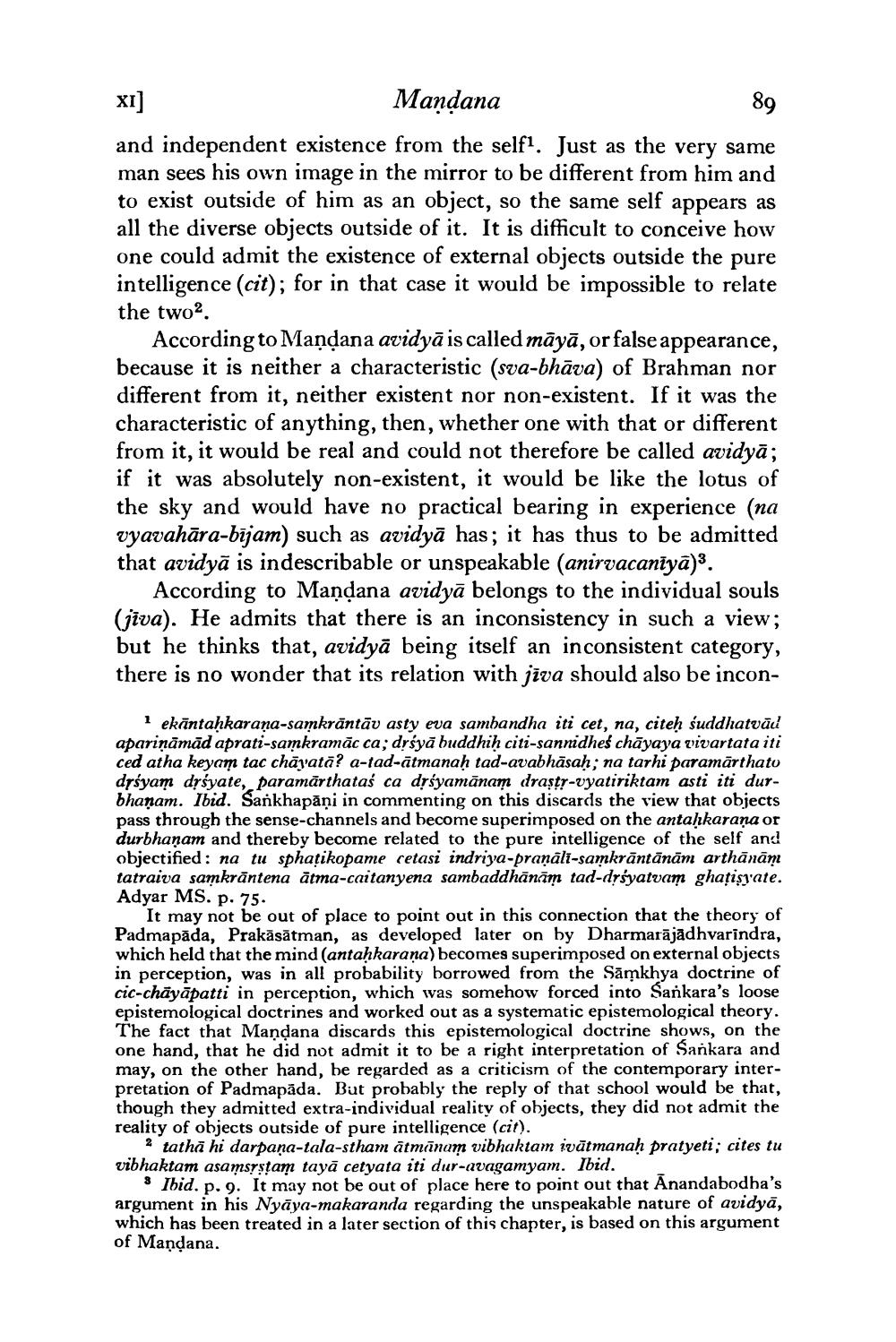________________
XI]
Mandana
89
and independent existence from the self1. Just as the very same man sees his own image in the mirror to be different from him and to exist outside of him as an object, so the same self appears as all the diverse objects outside of it. It is difficult to conceive how one could admit the existence of external objects outside the pure intelligence (cit); for in that case it would be impossible to relate the two2.
According to Maṇḍana avidya is called māyā, or false appearance, because it is neither a characteristic (sva-bhāva) of Brahman nor different from it, neither existent nor non-existent. If it was the characteristic of anything, then, whether one with that or different from it, it would be real and could not therefore be called avidyā; if it was absolutely non-existent, it would be like the lotus of the sky and would have no practical bearing in experience (na vyavahāra-bījam) such as avidya has; it has thus to be admitted that avidya is indescribable or unspeakable (anirvacaniyā)3.
According to Mandana avidya belongs to the individual souls (jiva). He admits that there is an inconsistency in such a view; but he thinks that, avidyā being itself an inconsistent category, there is no wonder that its relation with jiva should also be incon
1 ekāntaḥkaraṇa-samkrāntāv asty eva sambandha iti cet, na, citeḥ śuddhatvād aparināmād aprati-samkramac ca; drsya buddhiḥ citi-sannidheś chayaya vivartata iti ced atha keyam tac chayata? a-tad-atmanaḥ tad-avabhasaḥ; na tarhi paramarthato drsyam drsyate, paramarthatas ca drsyamānam draștr-vyatiriktam asti iti durbhanam. Ibid. Sankhapāņi in commenting on this discards the view that objects pass through the sense-channels and become superimposed on the antaḥkarana or durbhaṇam and thereby become related to the pure intelligence of the self and objectified: na tu sphaṭikopame cetasi indriya-praṇālī-samkrāntānām arthānām tatraiva samkrāntena ātma-caitanyena sambaddhānām tad-drsyatvam ghatiṣyate. Adyar MS. p. 75.
It may not be out of place to point out in this connection that the theory of Padmapāda, Prakāsātman, as developed later on by Dharmarajādhvarindra, which held that the mind (antaḥkarana) becomes superimposed on external objects in perception, was in all probability borrowed from the Samkhya doctrine of cic-chayapatti in perception, which was somehow forced into Sankara's loose epistemological doctrines and worked out as a systematic epistemological theory. The fact that Mandana discards this epistemological doctrine shows, on the one hand, that he did not admit it to be a right interpretation of Sankara and may, on the other hand, be regarded as a criticism of the contemporary interpretation of Padmapada. But probably the reply of that school would be that, though they admitted extra-individual reality of objects, they did not admit the reality of objects outside of pure intelligence (cit).
2 tatha hi darpaṇa-tala-stham ātmānam vibhaktam ivātmanaḥ pratyeti; cites tu vibhaktam asamsṛṣṭam taya cetyata iti dur-avagamyam. Ibid.
8 Ibid. p. 9. It may not be out of place here to point out that Anandabodha's argument in his Nyaya-makaranda regarding the unspeakable nature of avidya, which has been treated in a later section of this chapter, is based on this argument of Mandana.




